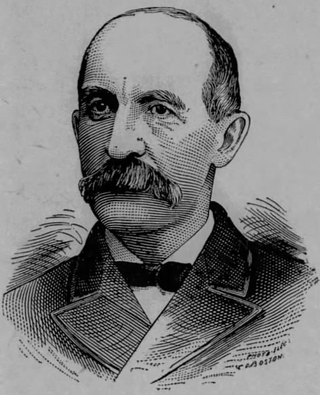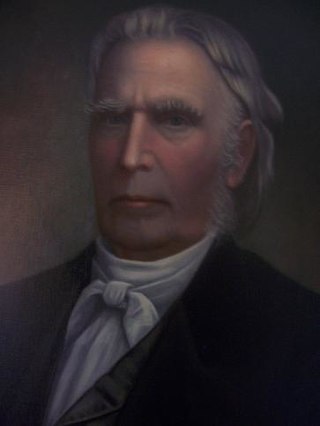
Lawrence Brainerd was an American businessman, abolitionist and United States Senator from Vermont. A longtime anti-slavery activist, after leaving the Jacksonians in the 1830s, Brainerd was active in the Whig, Liberty, and Free Soil parties, and was one of the organizers of the Republican Party when it was formed as the main anti-slavery party in the mid-1850s. Brainerd's longtime commitment to the cause of abolition was recognized in 1854, when opponents of slavery in the Vermont General Assembly chose him to fill a five-month vacancy in the United States Senate.

William Upham was an American attorney and politician from Montpelier, Vermont. He was most notable for his service as a United States senator from Vermont.

Frederick Holbrook was an American farmer, businessman, and Governor of the State of Vermont. Active in politics and government, first as a Whig, and later as a Republican, he was most notable for his service as the 27th governor of Vermont from 1861 to 1863.

Peter Thacher Washburn was a Vermont lawyer, politician and soldier. A veteran of the American Civil War, he served as the 31st governor of Vermont as a Republican from 1869 to 1870, and was the first Vermont Governor to die in office.

Henry Addison Fletcher was an American Civil War veteran, a farmer and a U.S. politician of the Republican Party. He is most notable for his service as the 38th lieutenant governor of Vermont from 1890 to 1892.

The Vermont Republican Party is the affiliate of the Republican Party in Vermont and has been active since its foundation in the 1860s. The party is the second largest in the state behind the Vermont Democratic Party, but ahead of the Vermont Progressive Party. The party historically dominated Vermont politics until the mid-20th century, but was replaced by the Vermont Democratic Party. The party currently has very weak electoral power in the state, controlling none of Vermont's federal elected offices. The only statewide office that the party controls is the governorship, currently held by Phil Scott.

Stephen Royce was an American lawyer, judge and politician. Originally a Democratic-Republican, and later a Whig Party, he became a Republican when the party was formed in the mid-1850s. Royce served as an associate justice of the Vermont Supreme Court from 1829 to 1846, chief justice from 1846 to 1852, and 23rd governor of Vermont from 1854 to 1856.

Levi Underwood was a lawyer and politician from Vermont. Originally a Democrat, Underwood's antislavery views caused him to join the new Republican Party when it was founded. Underwood was most notable for his service as the 23rd lieutenant governor of Vermont from 1860 to 1862.
Horatio Needham was a Vermont politician and lawyer who served as Speaker of the Vermont House of Representatives.

The 1974 United States Senate election in Vermont took place on November 5, 1974. The incumbent Republican Senator, George Aiken, did not run for re-election to another term in the United States Senate. The Democratic nominee, Patrick Leahy, the state's attorney of Chittenden County, defeated Republican nominee, Rep. Richard W. Mallary, to become Aiken's successor. This election also included Liberty Union Party candidate Bernie Sanders, who won 4.1% of the vote.
William Weston was an attorney and politician in Burlington, Vermont, and Brooklyn, New York. He served in several local and state offices, and is most notable for his service as a member of the Vermont Senate in the 1850s.

The 1866 Vermont gubernatorial election took place on September 4, 1866. In keeping with the "Mountain Rule", Incumbent Republican Paul Dillingham was a candidate for a second one-year term as governor of Vermont. With the election taking place soon after the American Civil War, Dillingham ran as a pro-Union Republican. The Democratic nomination was won by Charles N. Davenport of Wilmington, an attorney and founder of the Brattleboro Reformer newspaper, who was also the Democratic nominee in 1865. In the general election, Dillingham was easily elected to a second one-year term as governor.

The 1852 Vermont gubernatorial election was held on Tuesday, September 7. Incumbent governor Charles K. Williams, a Whig, was not a candidate for reelection. In the voting, Whig Erastus Fairbanks received 49.2 percent, Democrat John S. Robinson 31.3 percent, and Free Soil Party nominee Lawrence Brainerd 19.6 percent.

The 1851 Vermont gubernatorial election was held on September 2, 1851. The state continued its support for the Whig party, and Whig Governor Charles K. Williams was easily re-elected to a one-year term. The strong showing of the Free Soil Party candidate Timothy P. Redfield also showed that Vermont was on its way to becoming an anti-slavery bastion. The Democratic nominee, John S. Robinson went on to win the governorship in 1853.

The 1853 Vermont gubernatorial election took place on September 6. The same three candidates who ran for governor of Vermont in 1852 ran again in 1853: Whig and incumbent Erastus Fairbanks, Democratic candidate John S. Robinson, and Lawrence Brainerd, the nominee of the Free Soil Party. The results showed that Fairbanks had received 43.9 percent of the vote, with Robinson receiving 38.5 percent, and Brainerd 17.6 percent.

The 1855 Vermont gubernatorial election for governor of Vermont was held on September 4. With the Whig Party defunct after 1854, incumbent Stephen Royce, who had run with the support of both Whigs and the new Republican Party in 1854, ran as the nominee of the Republicans. The Democratic candidate was Merritt Clark, who had run unsuccessfully against Royce in 1854. James M. Slade, the Clerk of the Vermont House of Representatives was the nominee of the Know Nothing Party, also called the American Party.

The 1856 Vermont gubernatorial election for governor of Vermont was held on Tuesday, September 2. In keeping with the "Mountain Rule", incumbent Republican Stephen Royce was not a candidate for a third one-year term. The Republican nomination was won by Ryland Fletcher, the incumbent lieutenant governor. The Democratic nominee was Henry Keyes, a former member of the Vermont House of Representatives and Vermont Senate.

The 1861 Vermont gubernatorial election for governor of Vermont was held on Tuesday, September 3. In keeping with the "Mountain Rule", incumbent Republican Erastus Fairbanks, who had also served as governor from 1852 to 1853, was not a candidate for a third one-year term. The Republican nominee was Frederick Holbrook, a former member of the Vermont Senate. With the Democratic Party split nationally over the issue of slavery during the American Civil War, Andrew Tracy, a former member of the United States House of Representatives, appeared on the ballot as a pro-Union Democrat. Benjamin H. Smalley was on the ballot as a "Peace Democrat," Democrats who favored a compromise with the states that had formed the Confederacy.

The 1846 Vermont gubernatorial election took place on September 1, 1846, and resulted in the election of Whig Party candidate Horace Eaton to a one-year term as governor.

Green Mount Cemetery is a burial ground in Montpelier, Vermont. Located at 250 State Street, the 35-acre facility was established in 1854. It is operated by the City of Montpelier, and managed by the city's part time cemetery commission and a small full-time staff.














